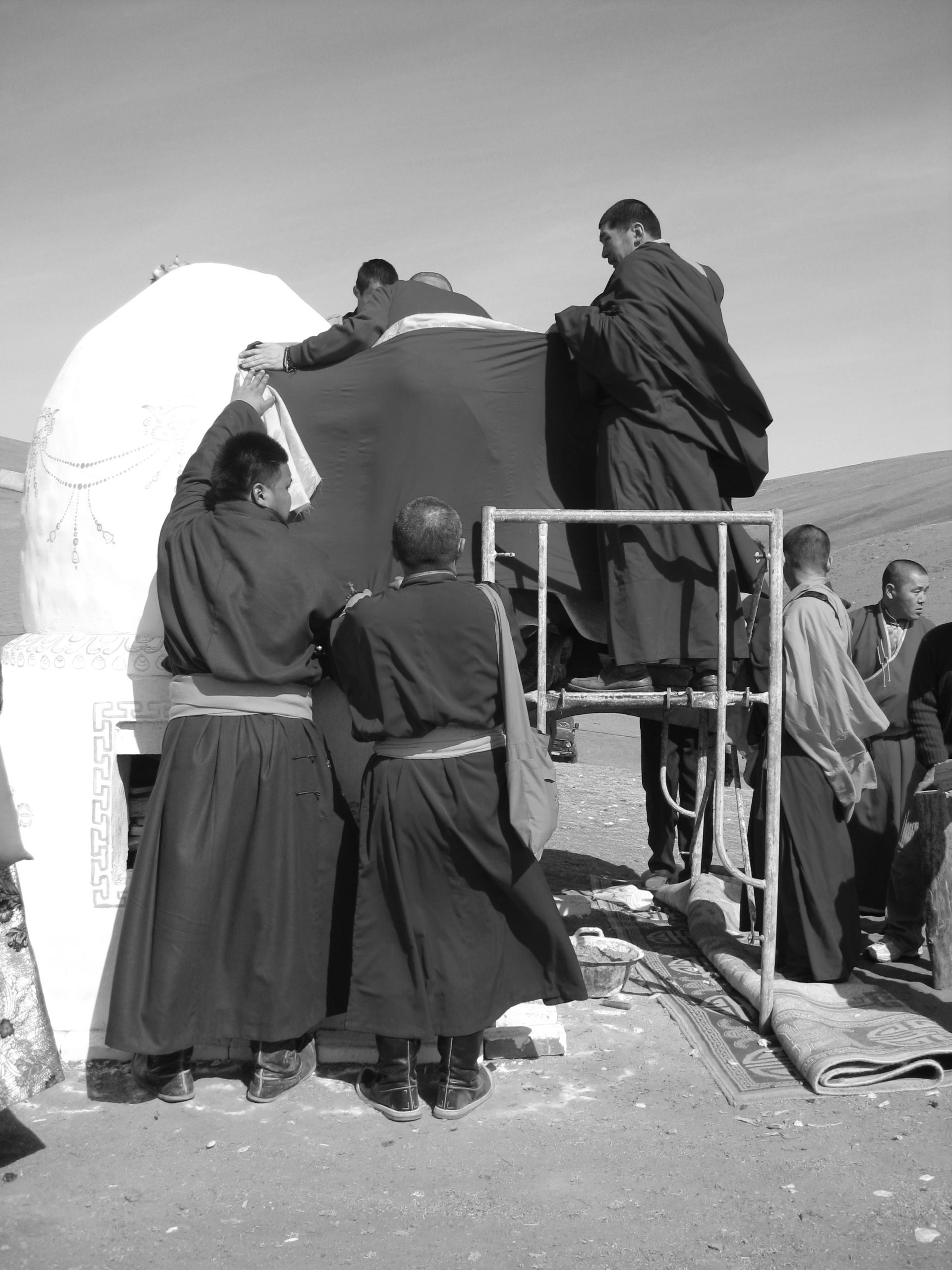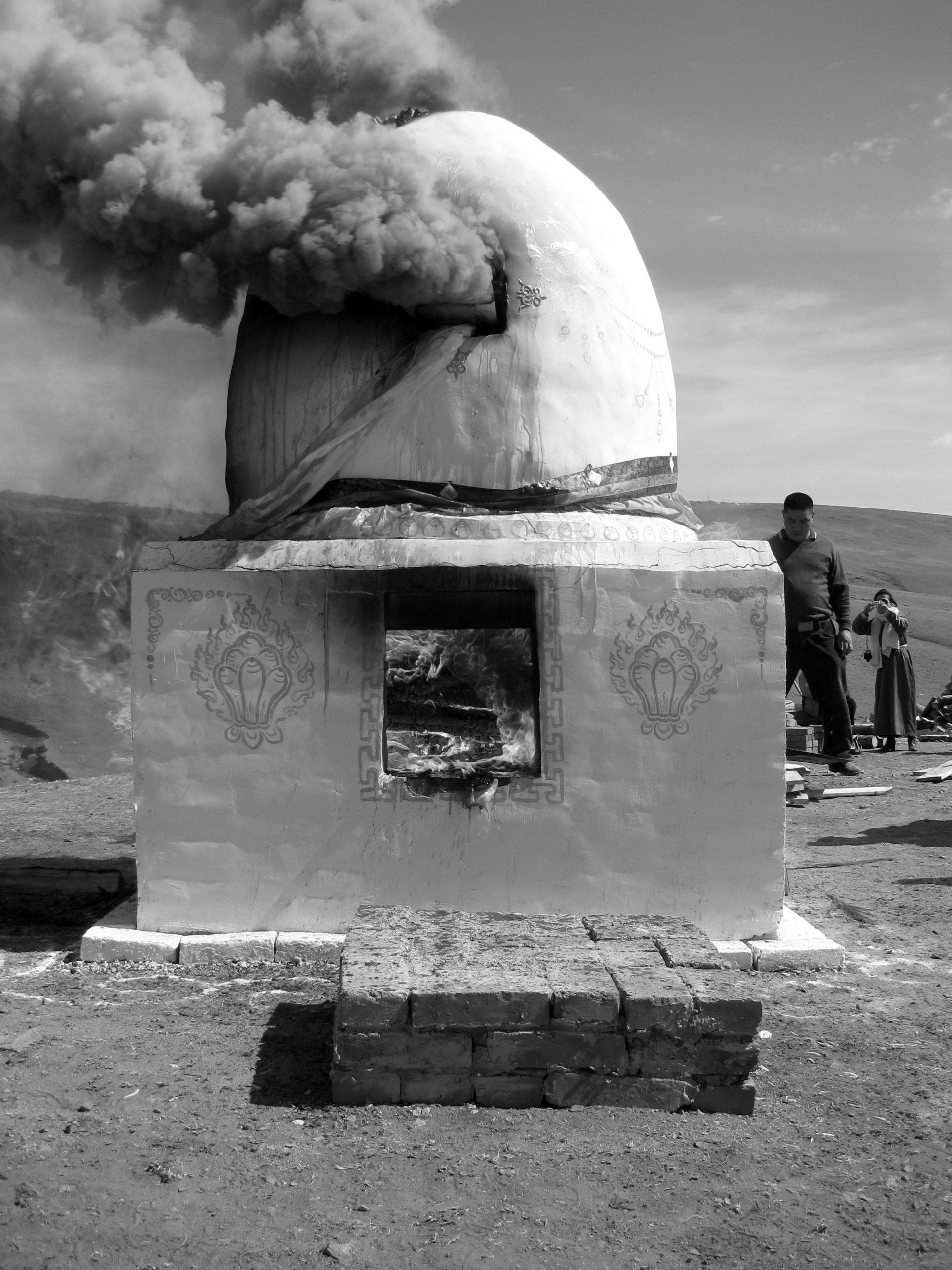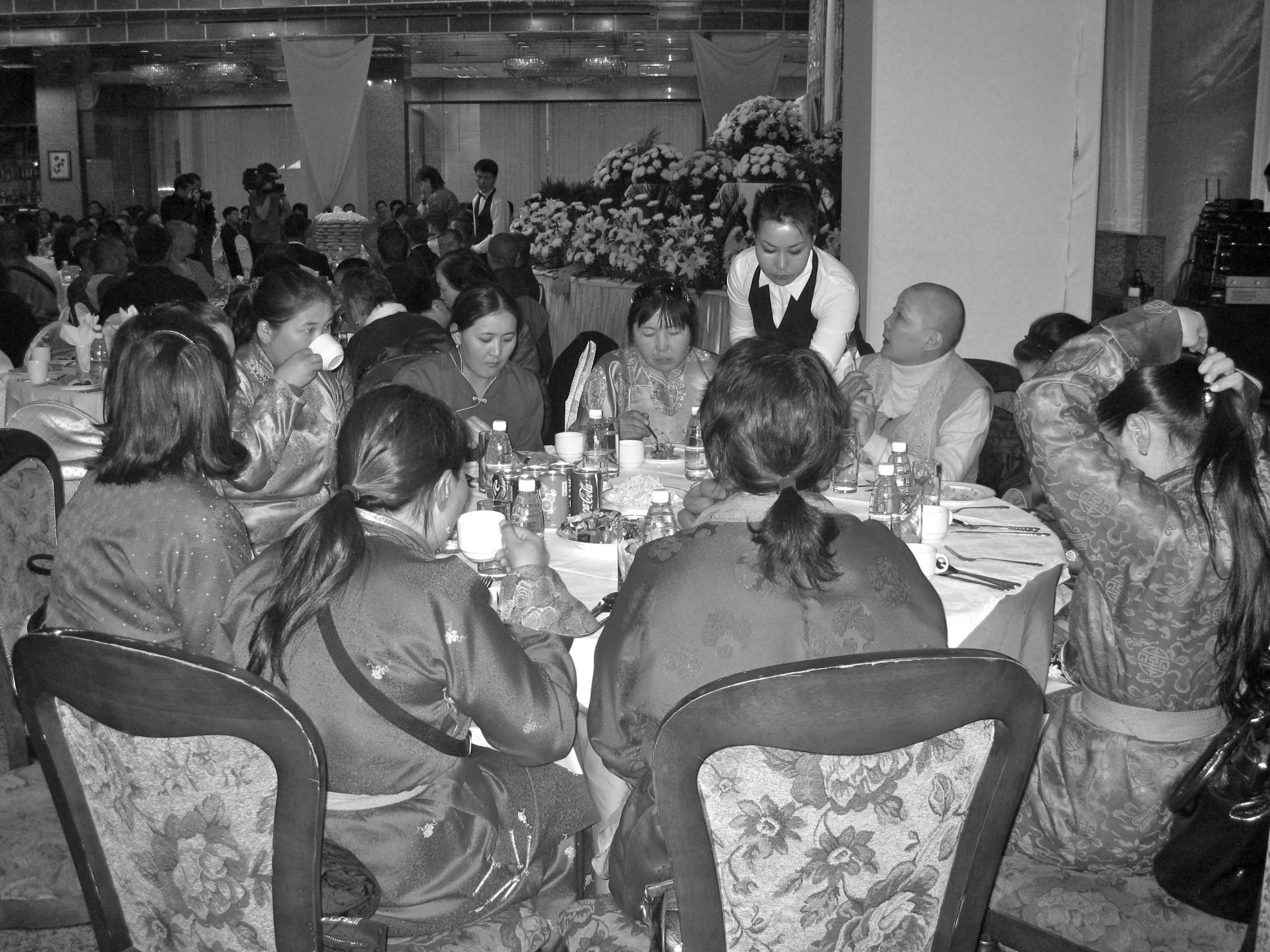![The view through the window of Guru Deva Rinpoche’s apartment in Ulanbator of the statue and open-access park he built for [his] Mongolian people. 12 April 2009. Photograph: C.Pleteshner.](https://s6561.pcdn.co/wp-content/uploads/2025/04/IMG_0097-scaled.jpg)
The view through the window of Guru Deva Rinpoche’s apartment in Ulan Bator of the statue and open-access park he built for [his] Mongolian people. 12 April 2009. Photograph: C.Pleteshner.
____________________________
This is a Mongolian Gelug story.
For my Mongolian friends and readers.
This is your history.
I’m just the scribe.
____________________________
In keeping with our practice of honouring elders, those who have come and gone before, today I’d like to pay homage to an elder now passed. On Tuesday 7th of April 2009, Mongolian Rinpoche Guru Deva, the incarnation of the great sage of India Mahasiddha Bundasiri passed away.
On Monday 13th April 2009, Rinpoche’s body was transported to the cremation grounds in the countryside an hour’s drive from Ulan Bator. I had the privilege of attending this important event.

Photo 1 of 12. Driving past Sukhbaatar Square and Mongolia’s House of Parliament in Peace Avenue in UB. All of the streets along the route in the capital had been officially closed to enable the procession to drive through the city at less than 10kph. The courtege from Ulan Bator with many hundreds of mourners making up the long procession of vehicles accompanying Guru Deva Rinpoche’s body to the cremation grounds in the countryside outside of Ulan Bator. As a sign of respect, a great honour, and as Zava Damdin Rinpoche’s authorised representatives, Dugarjav Lobsang Bilguun and Lobsang Sampel escorted the body of Guru Deva Rinpoche, from his apartment in Ulan Bator to the cremation grounds. As Guru Deva Rinpoche the previous year had instructed his chief Mongolian disciple Zava Damdin Rinpoche to enter a period of extended solitary retreat at his monastery Delgeruun Choira in the Dundgovi, Zava Rinpoche was unable to attend. To have done so, would mean breaking his retreat, and the vow he made to his heart’s Guru. 13 April 2009. Photograph: C.Pleteshner
Over a number if years, I compiled and wrote a book for Zava Damdin Rinpoche (1976- ) Guru Deva’s main disciple and Mongolian lineage holder who at this time in 2009 was only one year into his mandatory four year long solitary retreat in the Gobi. This photo essay is from that collection.

Photo 2 of 12. Having left Ulan Bator, the vehicle carrying Guru Deva’s body approaches the cremation ground. 13 April 2009. Photograph: C.Pleteshner
In sharing this story and some of the photographs, I hope to give you a sense of how it was, at that time. I took these photographs for Zava Bagsh who could not attend. How difficult that must have been …

Photo 3 of 12. Having left Ulan Bator, the vehicle carrying Guru Deva’s body approaches the cremation ground. The courtege from Ulan Bator with many hundreds of mourners making up the long procession of vehicles accompanying Guru Deva Rinpoche’s body to the cremation grounds in the countryside outside of Ulaanbaatar. As a sign of respect, a great honour, and as Zava Damdin Rinpoche’s authorised representatives, Dugarjav Lobsang Bilguun and Lobsang Sampel escorted the body of Guru Deva Rinpoche, from his apartment in Ulan Bator to the cremation grounds. As Guru Deva Rinpoche the previous year had instructed his chief Mongolian disciple Zava Damdin Rinpoche to enter a period of extended solitary retreat at his monastery Delgeruun Choira in the Dundgovi, Zava Rinpoche was unable to attend. To have done so, would mean breaking his retreat, and the vow he made to his heart’s Guru. 13 April 2009. Photograph: C.Pleteshner
How did I feel? Two thousand and nine was my sixth year visiting Mongolia. By this stage, like others in our circle, I felt a profound sense of grief and loss in terms of the absence of Guru Deva going forward, not so much for myself, but more for the now close Mongolian others in my midst. To this day one of my most treasured possessions is a camel wool blanket that Rinpoche gave me back in 2005. And on certain occasions, I wear garments sewn from silk fabrics, another gift from Mongolian Father Guru as he will always be known.

Photo 4 of 12. The palanquin (a sedan chair used to transport one person, and historically used for royalty or people of importance) that carried Guru Deva’s body from his apartment in Ulan Bator to the cremation grounds, having been carried by senior Mongolian Gelug monks, is positioned beside the funerary vestibule. As a sign of respect, a great honour, and as Zava Damdin Rinpoche’s authorised representatives, Dugarjav Lobsang Bilguun and Lobsang Sampel escorted the body of Guru Deva Rinpoche, from his apartment in Ulan Bator to the cremation grounds to this point. As Guru Deva Rinpoche the previous year had instructed his chief Mongolian disciple Zava Damdin Rinpoche to enter a period of extended solitary retreat at his monastery Delgeruun Choira in the Dundgovi, Zava Rinpoche was unable to attend these funerary rites. To have done so, would mean breaking his retreat, and the vow he made to his heart’s Guru. 13 April 2009. Photograph: C.Pleteshner

Photo 5 of 12. This photograph is of Sampel Lam, one of Zava Damdin Rinpoche’s two main disciples at Guru Deva’s funerary vestibule. As a sign of respect, a great honour and as Zava Damdin Rinpoche’s authorised representatives, Dugarjav Lobsang Bilguun and Lobsang Sampel escorted the body of Guru Deva Rinpoche, from his apartment in Ulan Bator to these cremation grounds. As Guru Deva Rinpoche the previous year had instructed his chief Mongolian disciple Zava Damdin Rinpoche to enter a period of extended solitary retreat at his monastery Delgeruun Choira in the Dundgovi, Zava Rinpoche was unable to attend these funerary rites. To have done so, would mean breaking his retreat, and the vow he made to his heart’s Guru. 13 April 2009. Photograph: C.Pleteshner
___________________________

Photo 6 of 12. Mongolian Guru Deva Rinpoche’s personal assistant and other lams ensuring the safe transfer of Guru Deva’s physical body from the palanquin into the firing vestibule in the cremation grounds outside Ulan Bator in Mongolia. 13 April 2009. Photograph: C.Pleteshner
____________________________________________
Death and Dying: solace in the face of impermanence
Various families in the Mongolian Gelug Buddhist community with which Nomadic Temple: Daughters of Tsongkhapa is primarily concerned, have gathered on a number of occasions whilst I was doing fieldwork between 2004 and 2009, to attend to matters and Buddhist rituals to do with death (boodalga Mong.Будаалга) and dying (booyani ajhil Mong. Буяны ажил).
Three older generation women, born in the 1920s and whom I met in 2004 and later interviewed in 2008, had already passed away. Other grandmothers within our extended kinship networks had also passed on. For a variety of reasons, one of the most significant events of this kind, for the whole community, was the passing of Lobsang Tenzin Gyatso Pal Sangpo Guru Deva Rinpoche into parinirvana[1] during the first week of April in 2009.

Photo 7 of 12. The fire underpinning the vestibule where Guru Deva Rinpoche’s body will be cremated is stoked to stir the fire, as mourners continue to arrive and pour in. Cremation grounds outside Ulan Bator in Mongolia. 13 April 2009. Photograph: C.Pleteshner

Photo 8 of 12. Having stoked the fire beneath the vestibule to the required heat conditions, the cremation of Guru Deva Rinpoche’s body commences. Cremation grounds outside of Ulan Bator in Mongolia. 13 April 2009. Photograph: C.Pleteshner

Photo 9 of 12. Ashes to ashes, dust to dust. Mongolian Guru Deva Rinpoche’s dissolution and cremation into our ‘atmosphere’ is done. Cremation grounds outside of Ulan Bator in Mongolia. 13 April 2009. Photograph: C.Pleteshner

Photo 10 of 12. At Mongolian Guru Deva Rinpoche’s cremation on 13 April 2009, those paying homage and respect were (proximally) divided into two separate groups: to the right, secular attendees including the Mongolian political class. Cremation grounds outside of Ulan Bator in Mongolia. 13 April 2009. Photograph: C.Pleteshner

Photo 11 of 12. At Mongolian Guru Deva Rinpoche’s cremation on 13 April 2009, those paying homage and respect were (proximally) divided into two separate groups: on the left, senior Tibetan clergy who flew in from overseas for the event, Mongolian Gelug Lamas and lams. Cremation grounds outside of Ulan Bator in Mongolia. 13 April 2009. Photograph: C.Pleteshner
________________________________
After the cremation of Guru Deva’s physical body on the morning of Monday 13th April 2009, a farewell gathering was held back in the nation’s capital, in the ballroom of Ulan Bator’s landmark Ghingghis Khan Hotel.[2] [3]
As many of the narratives of the Mongolian women in my study illustrate, Guru Deva Rinpoche played a very important role in their spiritual as well as day-to-day lives. Since his return to Mongolia in the 1990s, Rinpoche not only put his considerable personal and other resources into the Mongolian Gelug Buddhist reconstruction project, but he did so without distancing himself from hundreds of ordinary Mongolian people and their particular concerns.
Of course, the roles and relationships between their Teacher and his devotees who were Mongolian women varied from one to the other. But irrespective of generation, each of the Mongolian women in the study and with whom Guru Deva Rinpoche had a Teacher-disciple relationship were deeply affected by his passing. How and why is a story for another time.

Booyani ajhil (Mong. Буяны ажил) in honour of Mongolian Guru Deva Rinpoche. Main Ballroom of the Ghingghis Khan Hotel in Ulan Bator. 13 April 2009. Photograph: C.Pleteshner.

Photo 12 of 12. Mongolian Gelug nuns with their Abbess, who shaved off her beautiful long hair as her own personal offering to her Teacher, Mongolian Guru Deva Rinpoche. At the Booyani ajhil (Mong. Буяны ажил) in his honour. Main Ballroom of the Ghingghis Khan Hotel in Ulan Bator. 13 April 2009. Photograph: C.Pleteshner.
____________________________
Notes
[1] Parinirvana (Skt. parinirvāṇa; Pali: parinibbāṇa; Chinese: bō niè pán) occurs on the death of the body of someone who has attained complete awakening.
[2] Had I not been invited, I would not have been able to record the important historical, ritual and other social proceedings you see here.
[3] According to my Mongolian women friends, Mongolian people have a number of general terms that refer to such gatherings, those where people who participated in a funeral (or in this case a cremation) then come together to share a meal. Some say “boodalga” (Mong.Будаалга). Others refer to this as, “Booyani ajhil” (Mong. Буяны ажил.) Both have the same general meaning, that of offering a meal and serving guests in the memory of the one who has passed. To quote:
“It is a tradition for Mongolians to express thankfulness for all people who participated the funeral, and having a meal together means sharing grief. In old times the family welcomed them at home. In the countryside people still hold this meal at home, especially out in the countryside there are no restaurants at all. But lately people started to organise it out. It depends on how wealthy the family is, to choose the place for this after-funeral meal. Besides, for the famous people, case such as Rinpoche, everybody would like to be present, so it would be hard to organise the meal at home for this.
As the life style changes, the custom is changing too. In the old days nomadic people lived only in a ger, especially for poor people, they shared a ger with the passed one, and were [living there] at the same time when the funeral rite was taking place. Some family stayed home and moved that ger to another spot, so when people came back from the funeral [read as cremation or burial] they were welcomed to a newly-built ger, which means the new beginning for the members of the family and getting out of the grief, to start a new life style without the beloved who had just passed away. Impermanence!” [Extract (2008) original interview transcript]
______________________________
References
Pleteshner, C. (2011). Nomadic Temple: Daughters of Tsongkhapa in Mongolia. The Zava Damdin Sutra and Scripture Institute Library Archive in the Manjushri Temple, Soyombot Oron. Dundgovi Aimag, Mongolia. pp301-310.
Attribution
In keeping with ethical scholarly research and publishing practices and the Creative Commons Attribution 4.0 International License, I anticipate that anyone replicating the images or using/translating the text in this article into another language and submitting it for accreditation or other purpose under their own name, to acknowledge this URL and its author as the source. Not to do so, is contrary to the ethical principles of the Creative Commons license as it applies to the public domain.
end of transcript.
Please refer to the INDEX for other articles that may be of interest.
© 2013-2025. CP in Mongolia. This post is licensed under the Creative Commons Attribution 4.0 International License. Documents linked from this page may be subject to other restrictions. Posted: 7 April 2025. Last updated: 8 April 2025.